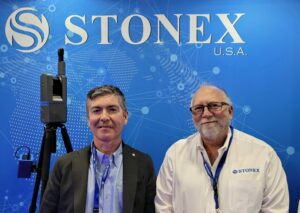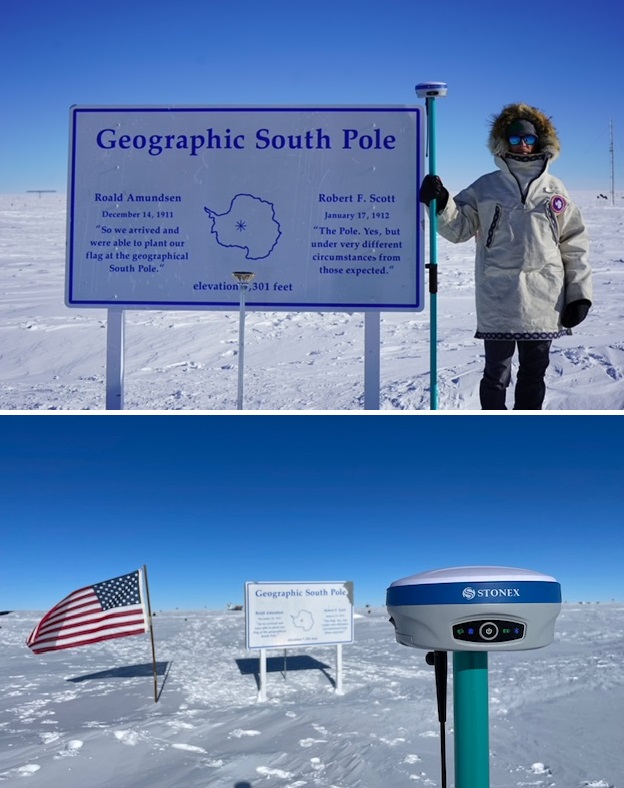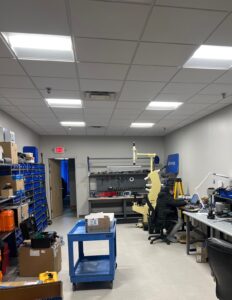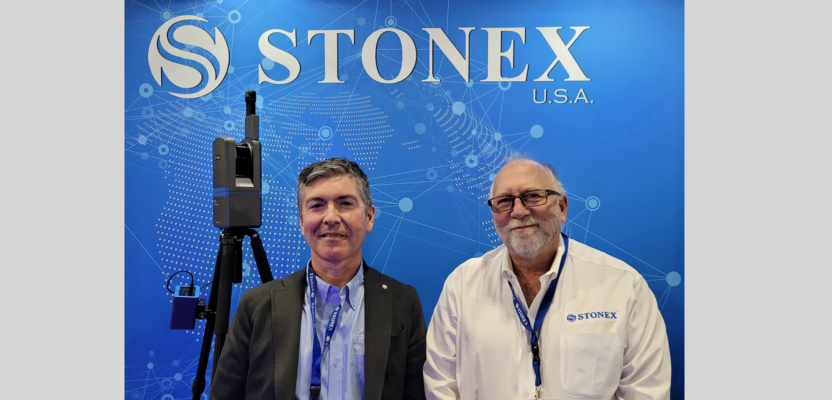While relatively new to the North American market, there are few in surveying who have not heard of this rising software and hardware provider. However, we often hear “Who is Stonex?” Let’s find out…
The following is the story of the rapid ascension of a specific, relatively new geospatial brand, but is also about how to do a successful launch and expansion in North America—something several international firms are trying to do.

Stonex chief executive officer Andre Bianchi and chief operating officer Ray Weatherbee at GeoWeek in Denver.
“Stonex is an Italian company founded in 2010 by Davide Erba, a young guy who had worked the in the field, in surveying,” said Andrea Bianchi, chief operating officer of Stonex. “In 2009 he had a revolutionary idea to make surveying instruments available for everyone. At that time, there were only a few big brands, and the hardware and software could be quite expensive.” The core idea was affordability without compromising quality.
Together with a team of electronics and manufacturing professionals, including Bianchi, Erba began specifying, designing, and manufacturing new products. After all, the technology and science behind, for instance, high-precision GNSS, was no longer limited to an exclusive club. In addition to instruments and software produced in Italy, they established Stonex facilities in China, in cooperation with some existing firms there. Stonex now has three main centers: Milan, Italy, Concord, New Hampshire, and Beijing, China; with a smaller presence in Shanghai.
“We began with GNSS receivers, and then total stations made in China,” said Bianchi. “And then we started the R&D for a static laser scanner with the same idea of an affordable instrument, within anyone’s reach. The X300 Android was designed, developed, and produced in Italy. This has been quite successful, and ironically, we began to sell this in China.” Their portfolio rapidly grew.
Stonex became a subsidiary of UniStrong Science and Technology in 2017. However, it remains quite independent. “At that time, UniStrong was already the owner of many companies,” said Bianchi. “Many of those companies were consolidated. However, Stonex kept its autonomy, continuing with the business as an independent company. All of the management was kept in Italy.” Stonex is also made up of independent groups, like Stonex USA.
North America
Many firms in the new international wave of geospatial hardware and software firms have sought to enter the North American market, often with mixed success. Challenges include loyal user bases of established firms, brand centricity of many distributors, and providing local service and support. While Stonex has had great success in Europe, Asia, South America, and the Middle East, and has been growing in Africa, to enter the U.S. market they knew that they needed to go big—and that approach has paid off.
“We started here in 2015,” Ray Weatherbee, chief executive officer of Stonex USA. “At the time, we had zero distribution in the U.S. and now, 75 of our 200 global distributors are in North America. Weatherbee has decades of experience and is well-known in the geospatial sector, including instrument sales and support.
“A lot of our international competitors think they can enter the U.S., market from abroad. That does not work well. You have to know distribution, know how distributors think and how to work with them. It’s taken us from 2015 to get us where we are today. We have a complete portfolio and a distribution and support network. Sales have grown rapidly.”
“What we did early on was to hire people that have a certain talent, and some that I’ve known in this business for a long time,” said Weatherbee. “I knew what they’re capable of doing. Everybody had experience, everybody had connections and contacts.”
Wetherbee traveled the country, to secure a foundation. He first visited mom-and-pop distributors that were not bound to specific brands. “They were easier to persuade,” said Weatherbee. “I showed them a great product, that is at an attractive price point, and with an aggressive dealer discount.” Since then, Stonex has made inroads with many larger dealers who are now finding it easier to expand their product portfolios without getting into trouble with legacy brands.
The other key step was investing in a major North American facility. While users now have a wide selection of new brands from global sources, a key consideration in choosing a product is a sales, service, and support network. Are products and parts readily available? Can you get ahold of someone when you need them? This is why Stonex established a 15,000-square-foot facility in Concord, New Hampshire, two-thirds of which is inventory. Weatherbee related that during the pandemic’s supply-chain issues, Stonex was able to keep products flowing. It turned out to be a period of rapid growth.
“After you get to a certain level, you need to build your infrastructure,” said Weatherbee. “We’re hiring more and more people, more boots on the ground, more support for service, marketing, R&D; doing it all here in the United States, to accommodate our growth. But at the same time, our entire worldwide business has also gone like this. We continue to go up.”
Portfolio
From core competencies in optical and GNSS systems, Stonex has expanded with hardware and software for surveying, mapping, GIS, precision agriculture, machine control, terrestrial and SLAM scanning, lidar for drones, mobile mapping, and solutions for mining, marine, energy, solar, etc. Some firms in the past have tried to zero in on one technology or market. Success in the geo space does not go hand-in-hand with such a strategy. The lateral benefits of portfolio diversification are broader user bases, market resilience, and engineering efficiencies realized through combined R&D.

Stonex equipment went all the way to Antarctica and proved its mettle in trying conditions.
Like a lot of firms, Stonex utilized OEM boards from other developers but are not bound to any in particular. “The R&D and product management team in Italy, we understand that you just don’t stay with one supplier, one board,” said Bianchi. “We’re constantly evaluating and incorporating boards from other manufacturers, because we want the best performance in our solutions and to evolve with the technology.”
An example of their flagship survey rovers is the S900+; 1408 channels, multi-constellation, with tilt compensation. I found it to be one of the top performers among similar rovers.
Quite a few of the emerging brands have good total stations, but few have full robotics.The Stonex R180 comes in 0.5” or 1”. According to the specs, it can shoot up to 1000m reflectorless.While I didn’t get to try anything quite that far, I found it to be as easy to use as those with similar capabilities from the big outfits.
For field software, there is the choice of third-party standards, like SurvCE or MicroSurey. Or Stonex’s own Cube-a (Android). For the latter, I took a quick tour and tried it. It was surprisingly easy to use for integrated surveying. The menus were intuitive and well thought out. Field software has improved a lot, pretty much across the industry. They also have Cube-connector, an Android app to control GNSS receivers—something great for asset mapping/GIS applications.
Weatherbee and Bianchi also emphasized that they are not just a hardware firm, but that software is even more of a core element of the company. Software brings the magic. They now have software to operate real-time GNSS networks (RTN) to complement their reference station hardware and geodetic antennas. There’s software for processing and management of surveyed data, photogrammetry, point clouds, and more.
Weatherbee is not shy about talking price. Their gear is not cheap, but it is noticeably lower priced than the high-end gear from the legacy manufacturers. While I recognize that for certain situations, a case could be made for buying top-end gear, the rise of the mid-range has brought high quality in a sweet spot of affordability.
For example, outfitting a survey crew with a base-rover pair, a robotic total station, a data controller, and software has traditionally been a pricey proposition. Weatherbee says this can be done with Stonex gear for under $70,000, especially with some attractive bundling options. I did some quick checking, and there are similar packages from others that are often nearly double that.
Taking the Leap
The entrance of Stonex into the North American market has been relatively recent, but rapid. A key to this has been the dealers—the critical front end of the sales, support, and service pipeline. The products needed to meet dealers’ standards before they would ever introduce them to customers.
“Like everyone else, we’d never heard of them,” said Antonio “Tony” Montanez of SiteSurv, a prominent surveying supplies firm in South Florida. “We had been selling a lot of total stations and levels back then but were getting more customers asking about adding [GNSS] rovers.” SiteSurv handed their Stonex demo unit to one of their most trusted and knowledgeable customers, and they loved it.
However, many customers took time to get on board. Especially some that might have never used GNSS or had used some ancient rover that maybe only got one (or two at the most) constellations—experiences that may have soured their view of GNSS. One licensed customer brushed off the idea initially, bemoaning the $20K price tag [of established brands] for a single network rover. Montanez was quick to point out that new Stonex rovers were not even half that price. Full constellation, now with tilt compensation, etc. Once customers saw them in action, their prior assumptions about GNSS were swept aside.

Stonex emphasizes repair, service, and support.
Then there’s the story of another initially skeptical customer. “I’d known this gentleman for a long time. He had always been a die-hard [established brand] user,” said Montanez. “I set up a demo with him. He had his rover, I had the Stonex. I went to take some shots next to a building. He was out in the open. He said, ‘what are you doing over there?’ I said I was fixed and taking shots. He said he could not do that. He had to fix out in the open.”
The customer eventually replaced all of its rovers with new rovers from Montanez.
Relationships mean a lot in the surveying equipment business. Given choices of gear of similar performance, support/service is often the tie-breaker. Some surveyors note that they are willing to pay for top end gear because it comes from an established ecosystem. What Stonex did was build an extensive ecosystem in a few short years. Weatherbee began with dealers he knew and hired people that also had established networks.
“When Ray brought Stonex to North America, he gave me a holler and said, ‘Hey, we got some new GPS.’ I said, really? He came down, we spent some time together,” said Ron Copley, of C&B Blueprint, a family run firm that has been serving West Virginia and adjacent areas of other states for 50 years. He liked the new gear Ray brought. Plus, the price point and dealer deals.
“What they’ve done in my opinion, is a really, really good job. We were probably one of the first, if not the first to offer Stonex gear,” Copley said. C&B started, like many dealers, as a blueprint shop, and added other engineering and surveying supplies. Copley said they had sold gear of other brands in the past but have done quite well adding Stonex.
We’re a small outfit. I’ve got two brothers in the company,” said Copley. “Our biggest thing has always been support. In the beginning, we could contact Ray or even Italy directly. Getting ahold of someone was not an issue,” said Copley.
The other thing C&B noticed as they started selling the new gear was that there were not a lot of issues. In general, survey gear and software has gotten more reliable, and transitions from older gear and software have become easier. Copley said that they can send gear to Stonex in New Hampshire if needed, but he says that if there are any issues, they’ve been able to handle them in-house more than 90 percent of the time.
One of Copley’s customers is Eagle Surveying of Charleston, West Virginia. “We do a variety of surveying; boundary, topographic, ALTA, construction layout, and laser scanning,” said Ricky Kinder. “We’ve had Stonex gear since 2015, including S900+ rovers, an R180 robot (total station), and an X300 laser scanner.” They began with Carlson software for their Stonex gear but are now also using the Cube-a field controller software and are learning Cube-3d now that they have added scanning. Kinder said they had recently had an opportunity to scan the dome of the state capital.
“Ron [Copley] introduced us to the Stonex gear, and showed us the capabilities versus competitors and versus the price,” said Kinder. “We are a small, family run shop with five people. That was definitely a factor. What we have is comparable to others that were a much higher price.”
A Wealth of Choices
I spent some time talking to users, having seen a rise in posts in recent years on surveying forums and groups mentioning or showing Stonex gear. Like a lot of surveyors, I had not heard about Stonex until relatively recently, and did not know much about the company. That was the impetus for researching the firm and writing this profile.
The kinds of comments I hear about Stonex echo what I hear from users of some of the other new entrants into the geo market. Folks have found that they have been able to move to the mid-range priced gear mostly without compromising quality. WhereStonex stands out is the broad portfolio, service, and support. Stonex’s “boots on the ground” in the U.S. has been a huge plus for them, their dealers, and customers.
Users I spoke to concurred with conclusions from my experience with Stonex. The gear is capable, easy to get used to, and it integrated into workflows well. The negatives I heard seemed to be more general frustration with switching from the comfort of legacy gear and software. I can relate, as I’ve had to switch many times.
I’ve noticed that the new wave of gear and software across the industry, Stonex’s included, has evolved to be more like consumer applications. No, not cheesy, or enabling unthinking “button pushing.” On the contrary, key elements of operation and data management are all there, with a depth that legacy “paleo-OS” software and controllers could never offer. Newer software is much easier to navigate than legacy, archaic menu structures. Like anything in professions such as surveying, modern tools and automation are not in and of themselves a bad thing. In the right hands, exercising diligence and best practices and applying knowledge of the underlying science and core principles, such tools can (and do) boost productivity.
The era of stringent brand loyalties has all but passed. There just weren’t full alternate portfolios to compete in the past. And while there are a few firms sticking to the top price tier, others aim for the bottom. The only thing worse than paying too much for gear might be paying too little. The sting of compromise lasts far longer than the bliss of an initial low price. However, mid-range offerings like Stonex have boomed.
Arguably, the mid-range may become the new standard. Times have certainly changed, with more choices—high quality, affordable choices. This has been great for surveyors and other geo practitioners.

